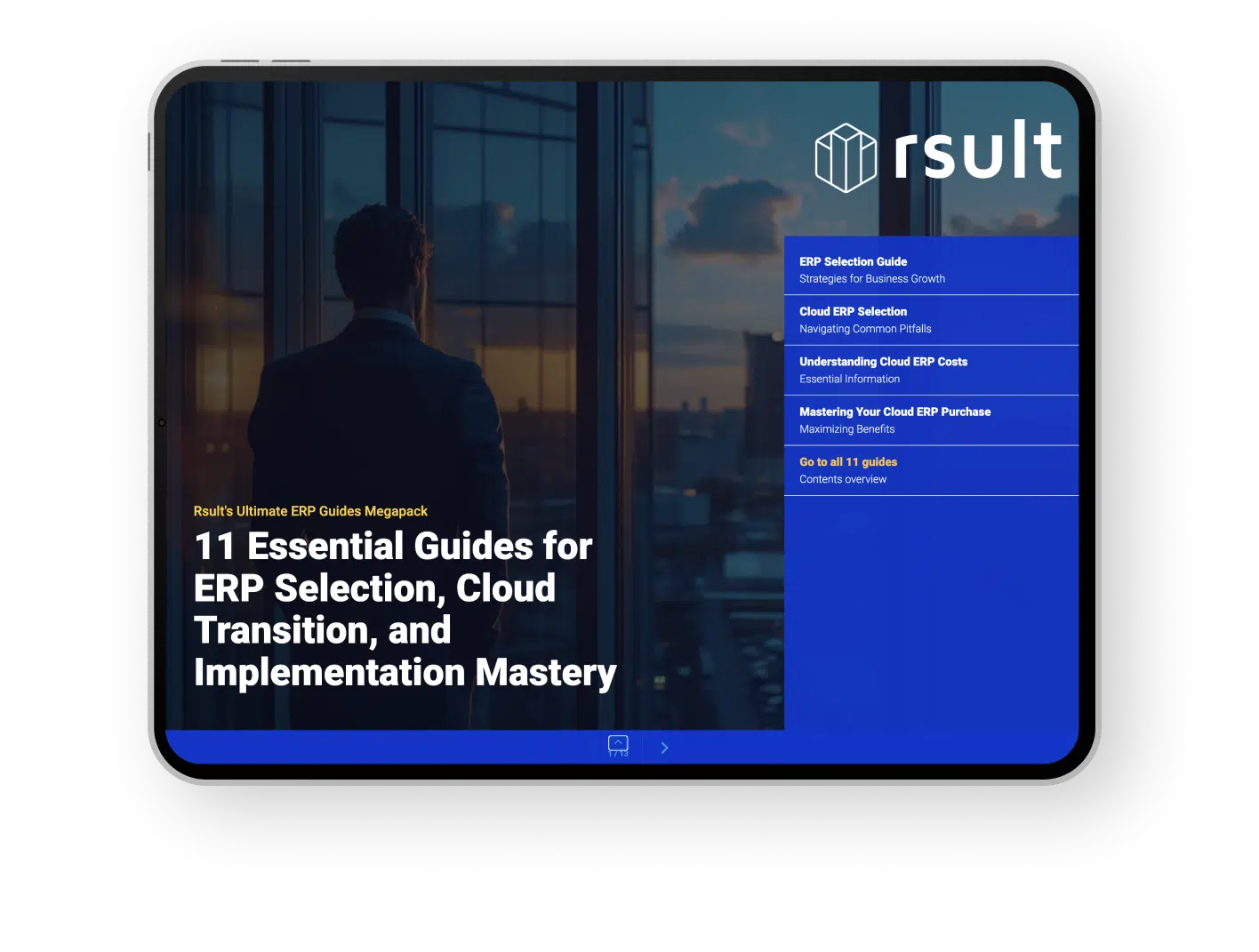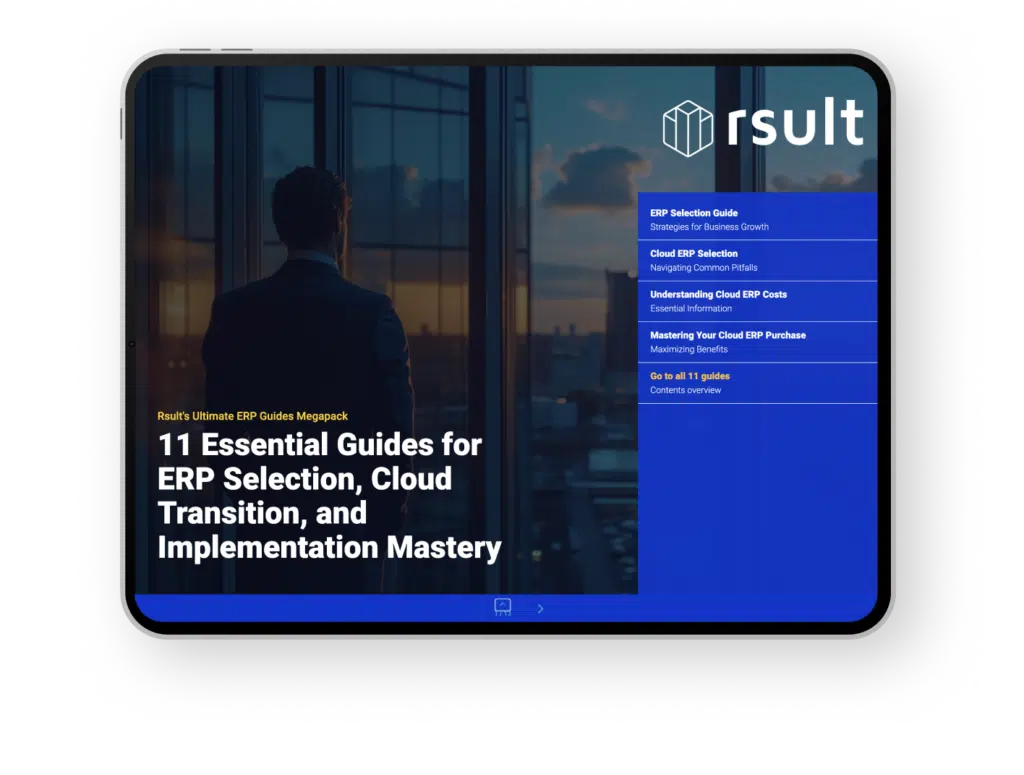Enterprise Resource Planning (ERP) systems have become a critical tool for businesses seeking to gain a competitive edge by consolidating management information and enabling efficiencies that support organizational growth. However, transitioning from traditional ERP solutions to cloud-based options demands significant attention to the financial advantages of such a move. By carefully considering the return on investment (ROI) and total cost of ownership (TCO) of cloud ERP benefits, businesses can better understand the potential impact on profitability that accompanies an ERP upgrade.
Key Takeaways
- Assessing the financial impact of an ERP transition requires careful analysis of capital and operational expenditures, as well as potential gains in efficiency and strategic benefits.
- ROI and TCO calculations play a pivotal role in identifying situations where cloud ERP adoption can lead to increased profitability.
- Cloud-based ERP solutions offer advantages such as enhanced accessibility, scalability, and continuous updates to system features.
- Security and privacy concerns must be addressed to ensure a smooth transition to cloud ERP without compromising data integrity and protection.
- A comprehensive implementation roadmap guides organizations through the complex process of cloud ERP adoption, increasing the likelihood of successful implementation and long-term benefits.
Introduction to ERP Transition
Transitioning to an ERP system involves a meticulous analysis of both direct and indirect costs associated with acquisition and deployment. These costs must be weighed against the long-term benefits that the system is expected to deliver for the business. Recognizing that ERP implementation is not an instant solution but an enabler for progressive change, organizations need to set conservative expectations for its economic advantages. In addition to immediate efficiencies, the strategic merits of simplifying processes, improving decision-making capabilities, and automating tasks play a crucial role in justifying the transition.
Undertaking a successful ERP transition requires the evaluation of various factors, including:
- Organizational readiness for change
- Alignment of business process automation with overall corporate strategy
- Availability of resources and budget for acquisition and deployment
- Compatibility between existing infrastructure and new ERP solution
- Training and skills development for smooth adoption and utilization by workforce
ERP upgrade benefits that organizations typically expect to achieve include:
- Streamlined and standardized business processes
- Enhanced visibility into company operations and performance metrics
- Improved decision-making through comprehensible and accurate real-time data
- Increased scalability and adaptability to future growth and market changes
- Reduction in manual, repetitive tasks and human errors
In summary, an effective ERP transition takes into account a balance between costs and expected long-term strategic benefits, and also the readiness and willingness of an organization to embrace the progressive change that comes with ERP implementation.
The Economic Justification for ERP Upgrades
Businesses must thoroughly analyze the financial aspects of ERP upgrades to ensure a positive impact on profitability. Assessing return on investment (ROI) and total cost of ownership (TCO) provide determining factors for identifying the economic justification of these upgrades. Additionally, proper recognition of capital and operational expenditures aids in the development of a comprehensive ERP investment plan.
ROI vs TCO: Measuring Profitability Impact
When evaluating ERP upgrades, it is crucial to measure ROI against TCO in order to project their impact on profitability. An ROI that surpasses the TCO signifies that the ERP upgrade has the potential to positively influence the company’s bottom line. This assertion hinges on a meticulous examination of all costs and benefits involved in the transition process.
Capital and Operational Expenditures in ERP Investment
Understanding the economic justification for ERP upgrades necessitates an evaluation of both capital and operational expenditures. Factors to consider include:
- Costs related to adopting new business models
- Expenses incurred in integrating technologies
- File conversion costs
- Workforce deployment expenses for ERP implementation
- Investment in team development to adapt to new ERP processes
By analyzing these elements, businesses can better grasp the overall ERP investment cost and make more informed decisions about their potential ERP upgrades.
Understanding the Full Cost Spectrum of ERP Implementation
To make an informed decision on ERP implementation, businesses must account for all associated expenses. This encompasses not only the obvious costs, such as acquisition and deployment, but also hidden costs that may arise throughout the process. By thoroughly analyzing these expenses, companies can establish a realistic budget and effectively manage risks.
Acquisition Expenses and Workforce Deployment Costs
ERP acquisition expenses involve the purchase of software, hardware, and other essential components for the new system. In addition, workforce training costs are an important factor to consider, as the deployment process often involves significant time and effort spent on employee education and adaptation. Integration of the new ERP system with existing technologies also contributes to the total cost, as does the potentially labor-intensive process of data migration from old systems and procedures.
Unexpected Expenditure in ERP Systems Overhaul
During an ERP systems overhaul, unforeseen expenses may emerge. These could include ERP testing costs to ensure full functionality after implementation or updates required to address compatibility issues with other software. Periodic reviews of the system’s performance should also be considered, as continuous evaluations can help refine the system and maximize its efficiency. Adequate financial provisions must also be made for risk management best practices to counter any unexpected expenses that may surface during the implementation process.
In conclusion, understanding the complete spectrum of costs associated with ERP implementation is crucial for businesses to make well-informed decisions on upgrading their systems. This entails accounting for acquisition expenses, workforce deployment costs, and the potential for unforeseen expenses that may emerge during the process. By closely examining these factors, companies can more effectively manage risks and ensure a successful transition to a new ERP system.
Long-Term Benefits of Modern ERP Solutions
Modern ERP solutions offer a myriad of long-term benefits that elevate organizational growth by transcending immediate cost savings. These benefits stem from various areas of resource optimization and management, yielding sustainable growth and efficiency. Some of these valuable benefits include:
- Streamlined resource management resulting in reduced manual handling expenses.
- Enhanced decision-making capabilities due to comprehensive monitoring and analysis of departmental and organizational performance.
- Seamless synchronization of departments, leading to more efficient cross-functional communication and collaboration.
- Scalability that allows businesses to grow and adapt to ever-changing market conditions.
These long-term ERP benefits collectively contribute to the realization of a robust organization capable of adapting to evolving market needs and staying ahead of the competition. The strategic advantages offered by modern ERP solutions further solidify their valuable position in shaping an organization’s growth trajectory.
| Benefit | Description |
|---|---|
| Streamlined Resource Management | Efficient allocation and utilization of resources, minimizing redundant tasks and costs. |
| Enhanced Decision-Making | Real-time access to crucial data, enabling informed and strategic business decisions. |
| Departmental Synchronization | Fostering seamless communication and collaboration across various departments for improved process efficiency. |
| Scalability | Ability to accommodate growth and change without compromising system performance, reducing the need for constant system upgrades. |
By leveraging modern ERP solutions, organizations can unlock these long-term benefits that contribute significantly to their overall growth and efficiency. The effects of streamlined resource management, improved decision-making, and seamless integration of departments foster a strong foundation for sustained organizational success.
The Strategic Importance of Resource Planning Automation
Resource planning automation has emerged as an invaluable asset for businesses, streamlining the management of records and reporting for more accurate forecasting and problem-solving capabilities. The strategic benefits of ERP are exemplified by its capacity to facilitate synchronized operations across various departments, empowering key decision-makers with crucial insights and enhancing overall efficiency.
Implementing automated resource planning processes enables businesses to:
- Improve accuracy of data collection and record-keeping
- Minimize manual errors and redundant tasks
- Enable agile decision-making based on real-time information
- Enhance collaboration and communication between departments
These advantages of resource planning automation, coupled with strategic ERP benefits, lead to significant efficiency improvement, contributing to a company’s bottom line and growth prospects. Consequently, organizations should wholly embrace the transformational power of resource planning automation to optimize their operations and secure a competitive edge.
Maximizing the Value from Enhanced ERP Functionality
Companies investing in ERP solutions must ensure that their investment yields maximum value by continually reviewing and updating business processes. This can be accomplished by collecting and analyzing quantitative data and personnel feedback related to resource planning. Regular process reviews allow businesses to adapt their operations to the enhanced functionality provided by the ERP system, thus ensuring a favorable return on investment (ROI) that surpasses the total cost of ownership (TCO).
Essential steps for ERP value maximization include:
- Monitoring and measuring key performance indicators (KPIs) related to the ERP system.
- Regularly engaging with users to collect feedback and suggestions for improvements.
- Conducting comprehensive process reviews to identify areas where the ERP system can enhance business operations.
- Implementing data-driven improvements and continually assessing their effectiveness.
By implementing these practices, businesses can ensure that their ERP system delivers tangible value, driving growth and success in an increasingly competitive market.
Why Cloud ERP Spells Efficiency for Enterprises
Cloud-based ERP systems, often provided as Software as a Service (SaaS), have revolutionized the way businesses manage their operations, introducing unprecedented levels of efficiency and adaptability. The accessibility, constant evolution, and overlap of flexibility and scalability benefits make cloud ERP an invaluable asset for modern enterprises.
Accessibility and Constant Evolution of SaaS ERP
SaaS ERP accessibility offers businesses the advantage of managing their operations anytime and from any location, all through an internet connection. This increased ease-of-use leads to enhanced productivity and responsiveness. Furthermore, the cloud-based ERP evolution ensures that systems remain up-to-date, providing businesses with the latest technological capabilities and improvements. As a result, enterprises can stay ahead of the curve and maintain a competitive edge in their respective industries.
Overlap of Flexibility and Scalability Benefits
Cloud ERP systems are designed with flexibility and scalability in mind, which contributes significantly to their efficiency. The ERP flexibility benefits enable businesses to add or remove users and adjust subscription plans as per their requirements, without worrying about the constraints of physical infrastructure. This flexibility leads to seamless adaptation to growth and changing business needs.
Moreover, ERP scalability allows enterprises to expand their systems and resources to accommodate a growing user base and increased operational demands. With cloud ERP, businesses can quickly scale up or down, depending on changing needs, which fosters efficient growth adaptation.
| Cloud ERP Advantages | Impact on Efficiency |
|---|---|
| Accessibility | Improved productivity and responsiveness |
| Constant Evolution | Maintaining a competitive edge with up-to-date technologies |
| Flexibility | Seamless adaptation to changing business needs |
| Scalability | Efficient growth adaptation |
In conclusion, cloud ERP systems introduce superior efficiency for enterprises through their accessibility, constant evolution, flexibility, and scalability. These advantages empower businesses to navigate complex operational environments effectively and adapt to the evolving demands of the modern marketplace.
Advantages of Shifting to Cloud-Based ERP Systems
Shifting to cloud-based ERP systems offers significant advantages that can greatly impact businesses. By adopting a cloud ERP solution, organizations can enjoy the benefits of cost-effective ERP solutions, enhanced mobility, and rapid deployment capabilities. Let’s explore these benefits more closely:
- Cost savings: One of the most attractive advantages of cloud ERP solutions is the substantial cost savings. With a SaaS ERP system, organizations can avoid upfront hardware and infrastructure expenses, allowing them to allocate their budgets more effectively.
- Enhanced mobility: Cloud-based ERP systems grant the flexibility and mobility necessary for remote management. By accessing the system from anywhere with an internet connection, employees can stay informed and make better decisions based on real-time data.
- Rapid deployment capabilities: Implementing a cloud ERP solution is often faster than traditional on-premise installations. Thus, businesses can save time and streamline their ERP transition, reducing the time it takes to realize the promise of increased efficiency.
Despite the many advantages of cloud ERP systems, it is important to consider potential drawbacks such as internet connectivity dependency and limited control over system upgrades. Nonetheless, organizations can benefit from the security and compliance handling afforded by vendors, who can help mitigate these concerns.
| Advantages of Cloud ERP | Potential Drawbacks |
|---|---|
| Cost savings due to reduced hardware and infrastructure expenses | Dependency on internet connectivity |
| Enhanced mobility for remote management | Limited control over system upgrades |
| Rapid deployment capabilities | Vendor reliance for security and compliance |
In conclusion, shifting to a cloud-based ERP system presents a wide range of advantages, making it an attractive option for businesses looking to optimize their resource planning processes. By carefully considering these benefits against potential drawbacks, organizations can make informed decisions about implementing cost-effective ERP solutions.
ERP for Construction: Specialized Advantages of Cloud ERP
Cloud ERP offers specialized advantages for the construction industry, catering to the unique needs of contractors, architects, and project managers. This customized approach, coupled with the flexibility and accessibility of cloud infrastructure, helps construction businesses streamline their operations and increase productivity. Some of the key benefits of embracing cloud ERP specialization in the construction industry are detailed below:
- Project Management Efficiency: Cloud ERP facilitates seamless collaboration between various project stakeholders, such as contractors, designers, and suppliers. Real-time data sharing and accurate project progress tracking improve decision-making and minimize delays.
- Financial Tracking: Integrated financial management features in cloud ERP systems enable construction businesses to easily track project budgets, expenses, and revenue generation. This allows for better cost control and overall financial performance assessment.
- Supply Chain Oversight: Cloud ERP solutions empower effective management of procurement processes and material logistics, ensuring timely availability of resources and reducing the likelihood of supply chain disruptions that may lead to project delays.
Besides these industry-specific advantages, cloud ERP for construction also inherits the general benefits of cloud-based solutions. These include lower upfront costs, seamless system upgrades, and convenient remote access to critical business data.
| Aspect | Benefit |
|---|---|
| Project Management | Enhanced collaboration and real-time data sharing |
| Financial Tracking | Improved cost control and financial performance assessment |
| Supply Chain Oversight | Effective management of procurement and material logistics |
| General Cloud Advantages | Lower upfront costs, simple upgrades, and remote accessibility |
By leveraging the power of cloud ERP specialization, construction businesses can optimize resource allocation, increase operational efficiency, and boost their overall cost-effectiveness. Adapting to industry advancements and embracing modern technology solutions, such as cloud ERP, can lead to a more successful and prosperous future for construction enterprises.
Assessing the Risks: Security and Privacy Concerns
Despite the numerous benefits offered by cloud ERP systems, concerns around data security and privacy due to Internet-based data access remain paramount. Since an organization’s sensitive and confidential information is stored on remote servers and often managed by third-party providers, businesses must take necessary precautions to mitigate potential cloud ERP risks.
Addressing these risks requires implementing trust and control mechanisms that promote reduced risk perceptions. Ensuring adequate ERP data security entails a multi-layered approach, including robust authentication and encryption methods, firewalls, and continuous monitoring for breaches.
Furthermore, privacy concerns in ERP systems can be alleviated by forging strong partnerships with reliable and reputable cloud service providers, coupled with service level agreements (SLAs) that guarantee compliance with industry-specific data protection standards and regulations.
Besides, businesses should develop and enforce clear internal policies regarding access control, data ownership, and data management. This includes the proper training of employees, limiting access to sensitive information to authorized personnel only, and conducting periodic audits to ensure compliance.
By taking a proactive approach in identifying and addressing potential security and privacy concerns, organizations can greatly enhance their comfort levels with the transition to cloud ERP and fully reap the vast array of benefits offered by this modern technology.
Navigating the SaaS ERP Landscape: Implementation Roadmap
Transitioning to a cloud-based ERP system, such as a SaaS ERP, necessitates a comprehensive and well-thought-out implementation roadmap. This strategic plan ensures a smooth adoption, minimizing potential roadblocks and challenges in the ERP transition roadmap. The following essential steps will facilitate successful SaaS ERP implementation and user adoption:
- Data migration preparation: Meticulously plan and execute the process of transferring business data from the current system to the new ERP solution.
- System configuration: Tailor the new SaaS ERP platform to meet your organization’s unique requirements and implement customizations as needed.
- User training and support: Provide your team with thorough and ongoing education and assistance to ensure smooth adoption and optimal usage of the new system.
- System testing: Conduct thorough testing of all system components and integrations, addressing any issues and optimizing performance before full implementation.
- Continuous performance monitoring: Regularly analyze system data and feedback from users to identify opportunities for improvement and streamline the ERP experience.
By following this cloud ERP adoption strategy, organizations can ensure a seamless transition to their new SaaS ERP solution, harnessing the platform’s capabilities for enhanced efficiency and growth.
The Role of Trust and Control in the Transition to Cloud ERP
Trust and perceived control play a critical role in the transition to cloud ERP by mitigating risks and enhancing the perceived benefits. With increased focus on service provider reputation, user authority management, and clear data control policies, businesses can transition to cloud ERP more confidently, knowing that benefits are upheld while costs are mitigated.
Some of the key ERP trust factors include:
- Service provider reputation
- Data security measures
- Certifications and compliance
Maintaining cloud ERP control is crucial for minimizing ERP risks. Establishing and enforcing robust user authority management policies helps ensure that access to sensitive data is granted only to authorized personnel. Moreover, having clear data control policies in place aids in managing and safeguarding vital organizational information.
Identifying and addressing potential risks early on allows businesses to adopt cloud ERP solutions with confidence. A risk assessment plan can be developed by considering and mitigating factors such as:
- Infrastructure vulnerabilities
- Privacy and legal compliance concerns
- Employee training and support requirements
- Potential unexpected costs
By paying close attention to the ERP trust factors and ensuring cloud ERP control, organizations can effectively minimize potential risks and embrace the benefits of cloud ERP with confidence.
| Trust Factor | Control Factor | Risk Mitigation Strategy |
|---|---|---|
| Service provider reputation | User authority management | Perform due diligence on service providers and establish robust access control policies |
| Data security measures | Data control policies | Implement stringent security measures and develop clear data management guidelines |
| Certifications and compliance | Infrastructure vulnerabilities | Ensure adherence to industry standards and address vulnerable infrastructure areas promptly |
| Privacy and legal compliance concerns | Maintain constant awareness and compliance with the latest privacy regulations and legal requirements | |
| Employee training and support requirements | Develop tailored training programs and provide ongoing support to facilitate successful system adoption | |
| Potential unexpected costs | Monitor and assess system performance, anticipate unplanned expenses, and allocate funds for their mitigation |
Conclusion
In conclusion, a thorough ERP transition analysis is essential for businesses considering the switch from traditional ERP systems to cloud-based solutions. This involves examining financial impacts and strategic implications to ensure that the advantages of a strategic ERP investment will yield positive outcomes on overall performance and growth.
Despite inherent security and privacy concerns, due attention to risk mitigation can alleviate these challenges, enabling organizations to confidently adopt cloud ERP solutions. By focusing on maximizing their potential benefits and cost savings, businesses can unlock the full potential of modern ERP technologies to enhance various aspects of their operations.
Ultimately, proper planning, implementation, and management play a crucial role in achieving a successful ERP transition. Embracing cloud ERP adoption can empower companies to stay competitive in today’s fast-paced digital landscape, harnessing cutting-edge tools and processes to drive efficiency and growth.
FAQ
What are the main financial advantages of transitioning to cloud ERP from traditional ERP?
Major financial advantages include cost savings due to reduced upfront hardware and infrastructure expenses, enhanced mobility for remote management, rapid deployment capabilities, and automatic system updates.
How can a business measure the ROI and profitability impact of an ERP upgrade?
Businesses can measure the ROI and profitability impact by comparing the total cost of ownership (TCO) with the expected return on investment (ROI). A favorable ROI that surpasses the TCO indicates that the ERP upgrade is likely to yield a positive impact on the company’s bottom line.
What costs are involved in the implementation of a cloud ERP system?
Costs include acquisition expenses, workforce deployment costs, system integration, data migration, and additional unforeseen expenses like testing costs and periodic reviews.
How do modern ERP solutions contribute to long-term organizational growth?
Modern ERP solutions support organizational growth by simplifying processes, improving decision-making capabilities, automating tasks, and providing comprehensive monitoring of departmental and organizational performance.
What strategic benefits does resource planning automation offer?
Resource planning automation provides benefits such as streamlined record-keeping and reporting, more accurate forecasting and troubleshooting, synchronized business operations, and the empowerment of key decision-makers.
How can a business maximize the value from enhanced ERP functionality?
Businesses can maximize value by continually reviewing and updating processes, harnessing quantitative data, and gathering feedback from personnel engaged in resource planning.
What are the benefits of accessibility and constant evolution in SaaS ERP?
Key benefits include the ability to manage operations anytime and from any location, ensuring that systems remain up-to-date and that businesses are equipped with the latest technological capabilities.
How does cloud ERP offer advantages for the construction industry?
Cloud ERP for construction streamlines project management, financial tracking, and supply chain oversight, leading to increased operational efficiency and cost-effectiveness.
What are the main security and privacy concerns in cloud ERP adoption?
Concerns include data security and privacy risks due to internet-based data access. Trust and control mechanisms are essential in addressing these risks and ensuring reduced risk perceptions.
What are the key steps to navigate the SaaS ERP landscape and implement a successful transition?
Essential steps include data migration preparation, system configuration, user training and support, thorough system testing, and continuous performance monitoring for improvements.






